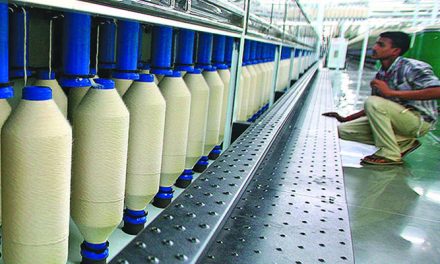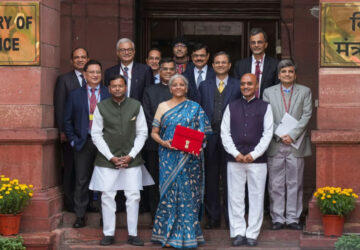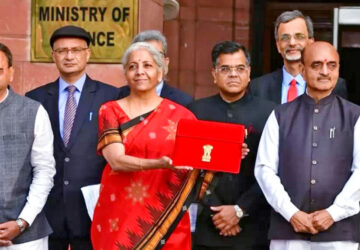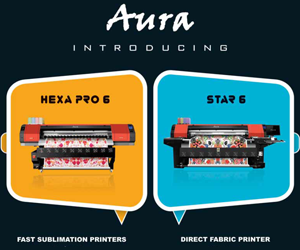Clothing, the basic needs of human being is to cover and also to protect the body from nature & external injury in a civilized society. Initially human being used to wear traditional attire but slowly got shifted to modern attire as both human’s mood and fashion trend moved in a dynamic way in an open market economy. The trend is experienced quite faster in the recent times as men’s wear in various categories got a sea change. ‘T’ shirt was a new addition in the first half of 1900’s and slowly became an attractive wear in apparel category across the consumer segment especially in the developed countries. T-shirt got an access in domestic market initially as especial winter attire and latter it had made an inroad in our wardrobe.
T-shirt is a style of unisex apparel and it is named for its ‘T’ shape body and sleeves. It was initially innovated as new apparel with short sleeve and round neck. It reveals in history that innovation of T-shirt could be traced in between 1898 during the Spanish and American war. It was reported that it had become visible, when US Navy army began using the garment for their army men and ‘T’ shirt came in open market in 1913 in USA. The product had slowly graduated to a regular category of apparel after a few decades. The word ‘T’ shirt became a part of American English in 1920. T-shirt is commonly popular in Latin American and Mongolian countries and worn by all categories of consumers irrespective of age and sex. Initially it was commonly used by sports person for specific games in India and slowly reached consumers wardrobe in last two decades. Today, it is the fastest growing apparel as it has an acceptance of various segments users for diverse purposes. Market report analysis indicates that till a couple of years back, share of T-shirt is around 8-10 per cent of total apparel market and a major part of the revenue came from unbranded products. It is expected to grow much faster than other apparel products in the coming years.
Various study reports indicated that Global market size of T-shirt across the globe was $185.1 bn in 2016 and it is expected to reach more than $200 bn by 2020. India’s market is also experiencing a dynamic change in the last decade as life style moves in a rapid changing mode, changing demographic structure, growing purchase capacity among middle class group and organisation’s strong attitude to brand building etc. T-shirt was mostly used by the consumers as casual wear till late 90’s. It got a boost once the MNCs started using T-1shirt as organization/office wear in various promotional activities, campaign for social cause and sports events etc. where company’s name or brand name were visible on T shirt. This had facilitated the multi national company to make their presence visible in the market and used it as a tool to reach consumers. However, majority of such products were commonly outsourced from unknown enterprises, which are usually un-registered and mostly established in tiny and small industry segment.
At present domestic market size is estimated to Rs. 20,000cr (approx.) and it may register a substantial growth in the next decade with the rapid change of lifestyle and growing consciousness of health and body fitness. Of course, traditional T-shirt won’t be sufficed to cater the demand hence; it needs to relook on market demand in depth.
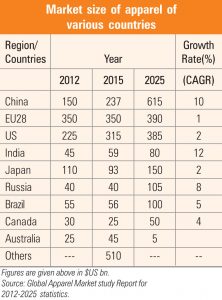 Global Apparel Market Study indicates that China, India and Russia will have a comfortable growth rate in apparel market demand in 2025, whereas; the developed countries will experience a slew in growth. This is perhaps market is slowly reaching a saturated point, but it depicts a different scenario in developing and under developing countries as there is enough room for growth. With the robust growth in economy in the recent years, consumer base in India got widened and consumers demand for clothing got a good start. The market study gives an indication of market size of apparel of various countries and growth rate till 2025.
Global Apparel Market Study indicates that China, India and Russia will have a comfortable growth rate in apparel market demand in 2025, whereas; the developed countries will experience a slew in growth. This is perhaps market is slowly reaching a saturated point, but it depicts a different scenario in developing and under developing countries as there is enough room for growth. With the robust growth in economy in the recent years, consumer base in India got widened and consumers demand for clothing got a good start. The market study gives an indication of market size of apparel of various countries and growth rate till 2025.
It is reported that per capita spending on apparel in developed countries is much higher than Global average spending, whereas it is much less or below global average in developing and under developed countries. Per capita spending in India is also considerably low compared to developed countries and average global spending. So it may not be a surprise, experiencing low spending on T-shirt consumption in India. It reveals from market statistics & data that per capita consumption of T-shirt is hardly around 10 per cent of apparel spending in India, which may get enhanced to 15 per cent in the coming years in the changed environment.
 It is reported that developed countries consume nearly 48 per cent of the total T-shirts across the globe and Canada, America and UK are the leading users of such product. Asia Pacific region is the up coming market in near future as these countries are registering an impressive growth in the changed environment. India is one of the fastest growing countries among Asia pacific countries. As per information available it is experienced that a few Developed and developing countries remained the leader of T-shirt consumers across the globe in 2015 as T-shirts are commonly used by consumers of all segments in diverse purposes.
It is reported that developed countries consume nearly 48 per cent of the total T-shirts across the globe and Canada, America and UK are the leading users of such product. Asia Pacific region is the up coming market in near future as these countries are registering an impressive growth in the changed environment. India is one of the fastest growing countries among Asia pacific countries. As per information available it is experienced that a few Developed and developing countries remained the leader of T-shirt consumers across the globe in 2015 as T-shirts are commonly used by consumers of all segments in diverse purposes.
T-shirt industry at a glance
T-shirt is a derivative of Shirt and it had been innovated after a few decades of shirt innovation. Shirt was innovated in 1831 in UK and T-Shirt was innovated in 1913 in USA. It is experienced that Tshirt industry is totally in fragmented in structure. There is no information on estimated units involved in manufacturing T-shirts in India. Manufacturing activity has remained an integral part of apparel industry till date though there is a rapid change in cutting & stitching style and quality of raw materials. There are onlya few units fully engaged in manufacturing T shirts in the country.
At present ‘T’ shirt industries are mostly concentrated in Tirupur, Ludhiana, Mumbai and Delhi including NCR etc. There was hardly any existence of a unit in organised sector initially, it was in early 90’s/ late 80’s a few enthusiastic entrepreneurs had made a humble beginning in manufacturing T-shirt. Till late 90,s, organised units were finding it a tough task to establish their brand in absence of strong visible market. The T-shirt industry got a boost only around the year 2000, when various organised sectors and multi-national companies started using T-shirt as office wear for diverse categories of staffs as well as various promotional activities were undertaken by big companies for the social cause, where T-shirt was a unique choice to all participants. This has spurted a huge demand in the domestic market.
Besides, sports wear also got a big jump during this period as a good no. of MNCs started campaigning of their products by organising various sports activities & campaign for body fitness. These organisations initiated the process of outsourcing products from domestic vendors, framing quality parameters. This was the beginning of huge activity of manufacturing T-shirt industry in India. In the recent years a few big players made an inroad in the domestic market, launching their products in various segments. There is no doubt Govt. Reservation Policy was to some extent responsible to create hindrance to growth. The policy got an amendment in 1993, which enable the manufacturers to invest at scalable level. It was after 2000, policy maker took a U-turn in the liberalized regime and rules ®ulations slowly got modified and later on abolition of reservation policy pave the way for established company to invest in manufacturing of such product without any export obligation. It has also made it easier to the leading domestic manufacturers to invest conveniently in manufacturing of readymade garments including ‘T’ shirt and place it for domestic consumption. This has resulted in availability of T-shirt at an affordable rate with an assured quality. It is expected that there will be enough room for growth of market for T-shirt as it is worn by both sex and kids.
Emerging market Scenario
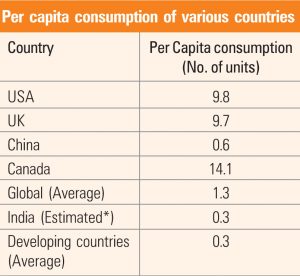 It is reported that T-shirt industry is growing faster than any other apparel sector because of market demand in the changed environment. India’s market for T-shirt is still on a high growth trajectory and there are huge opportunities to grow at a faster rate. Various studies indicated that growth rate of T-shirt in both categories of consumers will be around 12-13 per cent whereas market of other apparel will grow below 10 per cent. Though per capita consumption of T-shirt is still very low in India but industry is experiencing a growing demand because of changed life style, improved health consciousness, strict rules & regulations imposed in industrial safety and organisation brand building attitude etc.
It is reported that T-shirt industry is growing faster than any other apparel sector because of market demand in the changed environment. India’s market for T-shirt is still on a high growth trajectory and there are huge opportunities to grow at a faster rate. Various studies indicated that growth rate of T-shirt in both categories of consumers will be around 12-13 per cent whereas market of other apparel will grow below 10 per cent. Though per capita consumption of T-shirt is still very low in India but industry is experiencing a growing demand because of changed life style, improved health consciousness, strict rules & regulations imposed in industrial safety and organisation brand building attitude etc.
T-shirt market of India that includes knit shirts, Polo shirts, Knit tops and other athletic wear etc. and the market is dominated by men & boys segments. It is reported that 83 per cent of total market share is catered by male consumers. At present consumption ratio of T-shirt in respect of woven shirt in India is 1:2.5 whereas in Japan, the US and the EU it is 1.8-2.0. It indicates the low consumption rate of T-shirts in India. It was around Rs.13,830cr in 2014 and the market is expected to grow at an impressive growth rate 13 per cent to reach Rs.24,940cr in 2019. India’s T-shirt market is estimated to reach approximately Rs. 61,954cr in the next decade with a growth rate of around 12 per cent. Study reveals, T-shirt market is getting widened encompassing variety of sports shirt, office wear, casual wear, uniform and industrial wear etc. Besides, there is a growing attitude to use T shirt among the small and medium category traders and service providers in prominent market to make the company’s visibility strong and also to improve outreach.
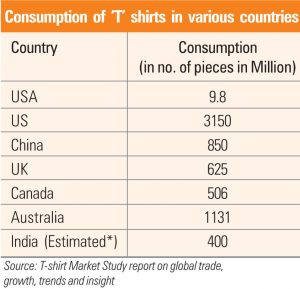 It is reported that Global market of T-shirt was $185.1bn in 2016 with a CAGR of 6 per cent for the period of 2017- 2025 and it is expected to grow at the level of nearly $300bn by 2025. Looking at the global consumption ofT-shirts per capita including India, it appears that there are only few countries having a bigger per capita consumption compared to other countries. A few developed countries like India and China may have significant consumption in terms of no. of pieces but per capita consumption remains below average due to big no. of population and seconds users.
It is reported that Global market of T-shirt was $185.1bn in 2016 with a CAGR of 6 per cent for the period of 2017- 2025 and it is expected to grow at the level of nearly $300bn by 2025. Looking at the global consumption ofT-shirts per capita including India, it appears that there are only few countries having a bigger per capita consumption compared to other countries. A few developed countries like India and China may have significant consumption in terms of no. of pieces but per capita consumption remains below average due to big no. of population and seconds users.
With the expected growth rate of consumption in domestic market and global consumption rate. It appears that India has got ample opportunity to tap the market. Indian manufacturers have to gear up to face the challenges ahead to make an inroad both in domestic and global market.
Conclusion
It is experienced that consumers purchase capacity rapidly grows in a developing economy and thus market grows much faster than other countries across the globe. India is no way exceptional. Uses of T-shirt were confined mostly as Casual wear till 90’s in India. Consumers life style in the changed environment had got a sea change in per capita consumption last two decades and there is a spurt in growth in consumption of T-shirt and is expected to register an exponential growth in the next decade. T-shirt was an important item of India’s clothing export basket till 2004in quota regime. Market demand of T-shirt was quite strong in various overseas countries. It is also reported that growth rate in men’s wear will be much faster than women and kids. Hence, there is strong need for innovation in design, geometrical structure, materials selection and adoption of updated technology to manufacture the variety of products to improve comfort and stress release etc. Indian manufacturers have to take a U turn from the existing manufacturing facilities to attain the improved features to meet the consumers’ desire and for a sustainable growth.



